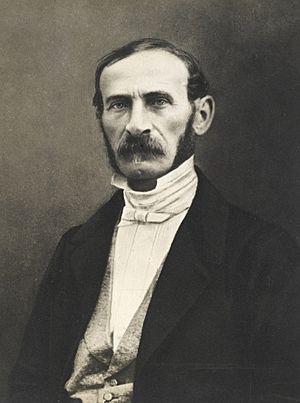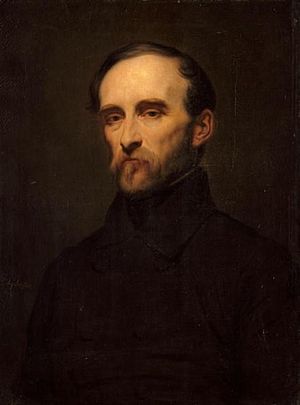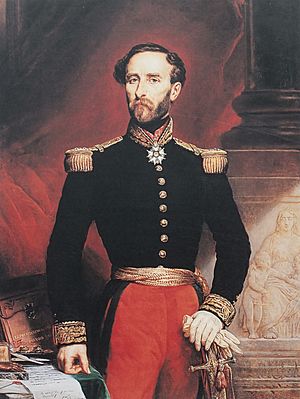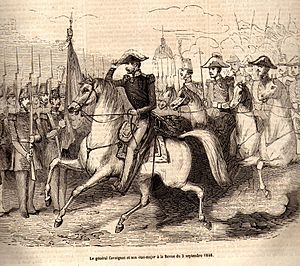Louis-Eugène Cavaignac facts for kids
Quick facts for kids
Louis-Eugène Cavaignac
|
|
|---|---|

Portrait by Pierre Petit, 1850s
|
|
| Chief of the Executive Power | |
| In office 28 June 1848 – 20 December 1848 |
|
| Preceded by | François Arago (as President of the Executive Commission) |
| Succeeded by | Louis-Napoléon Bonaparte (as President of France) |
| Minister of War | |
| In office 17 May 1848 – 29 June 1848 |
|
| President | François Arago |
| Preceded by | Jean-Baptiste-Adolphe Charras |
| Succeeded by | Louis Juchault de Lamoricière |
| In office 20 March 1848 – 5 April 1848 |
|
| President | Jacques-Charles Dupont de l'Eure |
| Preceded by | Jacques Gervais Subervie |
| Succeeded by | François Arago |
| Governor of Algeria | |
| In office 24 February 1848 – 29 April 1848 |
|
| President | Jacques-Charles Dupont de l'Eure |
| Preceded by | Henri d'Orléans |
| Succeeded by | Nicolas Changarnier |
| Personal details | |
| Born | 15 October 1802 Paris, France |
| Died | 28 October 1857 (aged 55) Flée, France |
| Resting place | Montmartre Cemetery |
| Political party | Moderate Republicans |
| Relations | Jean-Baptiste Cavaignac (father) Godefroi Cavaignac (brother) Jacques Marie Eugène Godefroy Cavaignac (son) |
| Awards | Commander of the Légion d'honneur |
| Signature |  |
| Military service | |
| Allegiance | |
| Branch/service | Army |
| Years of service | 1822–1852 |
| Rank | General of division |
| Battles/wars |
|
Louis-Eugène Cavaignac (born October 15, 1802 – died October 28, 1857) was an important French general and politician. He served as the temporary leader of France, known as the "Chief of the Executive Power," from June to December 1848. This was during a time called the French Second Republic.
Born in Paris, Cavaignac trained for a military career. After serving in the Morea expedition (a French mission to help Greece), he joined the July Revolution in 1830. In 1832, he went to Algeria to fight in the French invasion. He served there for 16 years and showed great skill.
Cavaignac began his political career after the French Revolution of 1848. He was elected to the National Assembly and became a leader of the Moderate Republicans. As Minister of War, he was given special powers to stop the June Days uprising in Paris. After ending the revolt, he gave up his special powers. The National Assembly then made him the temporary leader of France. He governed for almost six months. In the 1848 presidential election, he lost to Louis-Napoléon Bonaparte. Cavaignac remained in the National Assembly until it was dissolved in 1851. He then retired from public life.
Contents
Early Life and Military Training
Louis-Eugène Cavaignac was born in Paris on October 15, 1802. His father, Jean-Baptiste Cavaignac, was a politician who had been a member of the National Convention during the French Revolution. His mother, Julie-Marie Olivier de Corancez, came from a wealthy family in Paris. Louis-Eugène had an older brother, Éléonore-Louis Godefroi Cavaignac, who was also a republican activist.
In 1820, Cavaignac began his studies at the École Polytechnique, a famous French engineering school. Two years later, he continued his military training in Metz. After finishing his education, he joined the Royal Army as a sub-lieutenant in the military engineers. He became a lieutenant in 1826. From 1828 to 1829, he served in the Morea expedition, where France helped Greece in its fight for independence.
In 1830, the July Revolution broke out in France. Cavaignac, who was stationed in Arras, was one of the first officers to support the revolt against the king. He was promoted to captain in October 1830 under the new government.
Military Career in Algeria

In 1831, Cavaignac was temporarily removed from duty. This happened because he openly supported republican ideas. He was asked if he would fight against a republican uprising, and he said no. However, he was called back to duty in 1832. He was sent to Algeria to serve in the French invasion.
In the early years of the campaign, he fought in battles at Oran (1833), Mascara (1834), and Tlemcen (1836). His commanding officer, Thomas Bugeaud, praised Cavaignac as a skilled officer. In April 1837, he took command of a group of soldiers called zouaves. He also gained recognition for defending Tlemcen for 15 months and for his actions in Cherchell in 1840.
Cavaignac earned most of his promotions on the battlefield. He became a lieutenant-colonel in 1840, a colonel in 1841, and a maréchal de camp (a type of general) in 1844. As he rose through the ranks in Algeria, he kept less in touch with his republican friends in France. In the last years of the July Monarchy, Cavaignac was made governor of the province of Oran.
Start of Political Career

After the French Revolution of 1848 and the start of the Republic, Cavaignac was promoted to general of division. He was appointed Governor General of Algeria by the new French government. On March 20, he was offered the job of Minister of War, but he turned it down.
About a month later, Cavaignac returned to France. He took his seat as a representative for the Lot region in the National Assembly. He had received the most votes in that area during the 1848 election.
Cavaignac arrived in Paris on May 17, 1848. On the same day, he accepted the role of Minister of War, which he had previously refused. In the National Assembly, he joined the Moderate Republicans. He had a public disagreement with Georges-Charles de Heeckeren d'Anthès, which led to a lasting rivalry between Cavaignac and Louis-Napoléon Bonaparte.
The June Days Uprising
On June 23, 1848, a large workers' uprising began in eastern Paris. This event became known as the June Days uprising. The government put Cavaignac in charge of stopping it. By June 24, the situation was so serious that the National Assembly gave Cavaignac special dictatorial powers. They also dissolved the Executive Committee that had been leading the country.
Cavaignac saw the uprising as a military problem. He used the regular army and the National Guard to fight the rebels. He did not hesitate to use cannons to break through the barricades the workers had built. His troops advanced in strong columns, fighting for every inch of ground. Government troops were often pushed back, needing more soldiers. Finally, Cavaignac reached the main rebel area at the Place de la Bastille and crushed the uprising. By June 26, the revolt was over.
Cavaignac and other Moderate Republicans believed they had saved the young Republic. He had put down the revolt with strong determination. Some people, like Alphonse de Lamartine, even thought Cavaignac had waited on purpose. They believed he let the protests grow so that his final victory would be more complete.
Chief of the Executive Power
After stopping the uprising, Cavaignac appeared before the National Assembly. He announced that he would give up the special powers they had given him. He did this on June 28. The parliament then confirmed him as the "Chief of the Executive Power" (Chef du pouvoir exécutif).
As a strong supporter of the Republic, Cavaignac worked to protect the democratic government that had just been created. He chose his government ministers carefully. Many of them were connected to Le National, a newspaper that supported the Moderate Republican majority.
Early in his time as leader, Cavaignac took control over political clubs. He also shut down left-wing newspapers that he believed were causing the June uprising. He temporarily stopped the publication of eleven newspapers. Later, in August, he permanently banned four journals, calling them "instruments of civil war."
As decided by the National Assembly before the June Days, Cavaignac closed the national workshops in July. These workshops had provided jobs for the unemployed. The government then offered direct help to people and started large public works projects to reduce joblessness. Cavaignac's government also supported worker cooperatives. They passed laws about maximum working hours for factory workers and helped modernize the French postal system. During this time, a democratic constitution was prepared by the National Assembly with Cavaignac's support.
In foreign policy, Cavaignac's government generally continued the previous government's approach. They showed sympathy for national movements in other parts of Europe, especially in Italy, Germany, and Poland. However, they avoided getting directly involved in conflicts. The main concern was the First Italian War of Independence against the Austrian Empire. After an Austrian victory in July, Cavaignac prepared an army to help Piedmont-Sardinia, but he did not send them because he was not asked to.
The Presidential Election

On October 8, the National Assembly decided that the President of the Republic would be chosen by popular vote. As the election day got closer, it seemed clear that the main candidates would be Cavaignac and Louis-Napoléon Bonaparte. Both tried to get the support of the conservative Party of Order. Cavaignac even brought two Orleanists (supporters of the royal family) into his government in October. He also tried to get the support of Adolphe Thiers, a leader of the Party of Order. However, Thiers thought Cavaignac was too left-leaning. Thiers preferred Louis-Napoléon, who seemed less connected to radical groups.
After much discussion, the Party of Order decided not to support any candidate. Cavaignac's supporters had hoped the party would choose their own candidate. This would have split the votes and increased Cavaignac's chances. If no candidate won a majority, the National Assembly would make the final decision, and Cavaignac had their support. However, the lack of a third candidate helped Louis-Napoléon, who was very popular with ordinary people. Even so, Cavaignac was supported by most French newspapers.
Voting took place on December 10 and 11. Early results showed that Louis-Napoléon would win easily. Cavaignac was reportedly urged by his advisor, Jean-Baptiste-Adolphe Charras, to seize power by force. But Cavaignac refused. He believed that even if the Republic failed, it would rise again. Louis-Napoléon won the election with 74% of the votes. Cavaignac came in second with 19.5%. Cavaignac only won a majority in four regions: Finistère and Morbihan in Brittany, and Bouches-du-Rhône and Var in Provence.
On December 20, power was peacefully transferred in the National Assembly. In a short farewell speech, Cavaignac thanked the parliament and resigned from his position. He then returned to his seat as a member of the Assembly. The president of the parliament, Armand Marrast, then announced Louis-Napoléon as the new President of the Republic.
Later Life

Cavaignac continued to serve as a representative in the National Assembly. He was reelected in May 1849 for the Lot region. He usually voted with the opposition. He voted against sending a military force to stop a republican revolution in Rome. He also opposed a law from May 31, 1850, which limited universal male suffrage (the right for all men to vote).
The anti-suffrage law was approved. Later, Louis-Napoléon used the idea of revoking this law as an excuse for his coup d'état on December 2, 1851. In this event, Louis-Napoléon seized complete power and dissolved the National Assembly.
In the early hours of December 2, Cavaignac was arrested at his home in Paris, along with other opposition members. He was first held in Mazas Prison and later moved to the Château de Ham. He was released on December 29 to marry Mademoiselle Odier, a young woman from a banking family. They were engaged when he was arrested.
After his marriage, Cavaignac retired from the army. Their son, Jacques Marie Eugène Godefroy Cavaignac, was born in May 1852. Under the French Empire (when Louis-Napoléon became Emperor Napoleon III), Cavaignac was elected to the Corps législatif in 1852 and 1857. However, he refused to take an oath of allegiance to the Empire. Because of this, he was not allowed to take his seat.
In 1855, Cavaignac bought a country house called the Château d'Ourne in Flée, Sarthe. He died there on October 28, 1857, at the age of 55. His funeral was held in Paris. He was buried next to his brother Godefroi in the Montmartre Cemetery in Paris.
See also
 In Spanish: Louis-Eugène Cavaignac para niños
In Spanish: Louis-Eugène Cavaignac para niños
- Cabinet of General Cavaignac
- French Algeria



